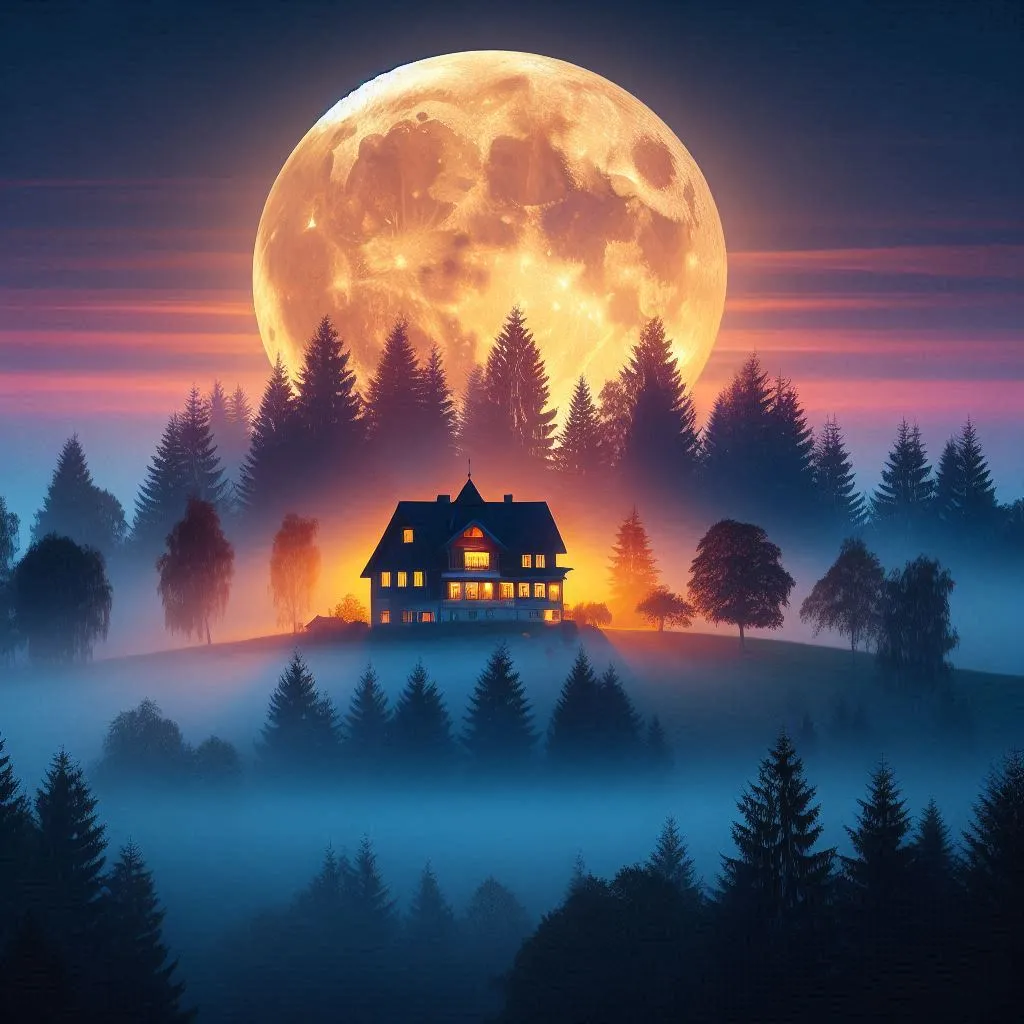
The Moon: A Celestial Beauty Enhancing Our Local Landscape
The moon has captivated humanity for millennia, serving as a constant companion in the night sky, a source of wonder, and an inspiration for countless myths, poems, and scientific inquiries. Its serene presence has fueled our imaginations and played a crucial role in the rhythm of life on Earth. But beyond its scientific significance and mythological allure, the moon offers an unparalleled aesthetic experience, especially when viewed in the context of our local landscapes.
In this piece, we’ll explore the moon's beauty and detail, examining how its presence complements and enhances the landscapes we inhabit. From the technical aspects of lunar observation to its emotional impact on our sense of place, the moon’s interplay with our surroundings is a rich subject worth exploring.
The Moon's Aesthetic Appeal
The moon’s aesthetic appeal lies in its simplicity and complexity, a paradox that makes it endlessly fascinating. At first glance, the moon may seem like a simple, glowing orb in the sky. However, a closer look reveals a surface teeming with detail—craters, mountains, valleys, and plains—that tells the story of its violent past. This dichotomy between simplicity and complexity is what makes the moon so captivating.
The Surface Details: A Closer Look
When we observe the moon, especially during a full moon phase, the details of its surface become more prominent. The dark patches, known as maria (Latin for "seas"), are vast plains of solidified lava. These maria are contrasted by the lighter highlands, which are older and more cratered, bearing the scars of countless impacts over billions of years.
Each crater tells a story of a collision with an asteroid or comet, and the rays extending from some of the larger craters, such as Tycho or Copernicus, are a reminder of the immense energy released during these impacts. The sharpness of these details, visible even to the naked eye, or with a simple telescope, is a testament to the moon's rich geological history.
For those who want to delve deeper, a high-quality telescope can reveal even more intricate details, such as the rugged mountain ranges that line the edges of some maria or the deep valleys that cut across the lunar surface. Observing the moon through a telescope is not just a visual experience but a journey through time, offering a glimpse into the history of our solar system.
The Emotional Impact: A Constant Companion
The moon's emotional impact is undeniable. It has been a source of comfort, a symbol of romance, and a beacon of hope throughout human history. Its regular phases offer a sense of continuity and rhythm in a world that is often chaotic and unpredictable. Whether it's the thin crescent of a new moon or the bright fullness of a harvest moon, the sight of the moon can evoke a wide range of emotions.
For many, the moon is a reminder of home, a celestial body that has been a constant presence throughout their lives. It is there during quiet nights when one gazes out of a window, during late-night walks under a starry sky, or when camping in the wilderness far from the lights of the city. In each of these scenarios, the moon serves as a focal point, drawing our attention upward and encouraging reflection.
The Moon and the Local Landscape
While the moon is a universal object, its beauty is often enhanced by the context in which it is viewed. The local landscape plays a crucial role in framing our perception of the moon, turning a simple observation into a memorable experience.
Urban Landscapes: A Beacon in the Sky
In urban environments, the moon often serves as a counterpoint to the artificial lights that dominate the night. City lights, while beautiful in their own right, can sometimes overwhelm our senses. The moon, however, cuts through this brightness with its gentle, steady glow. It is a reminder of the natural world, a connection to something greater and more enduring than the fleeting lights of a city.
In photography, capturing the moon against an urban backdrop can create stunning images. The contrast between the modern, angular shapes of buildings and the ancient, round shape of the moon can be striking. For photographers, this juxtaposition offers endless creative possibilities. By experimenting with different angles and exposures, one can highlight the moon’s ethereal presence against the structured rigidity of the urban landscape.
Rural and Suburban Landscapes: A Natural Harmony
In rural and suburban settings, the moon often feels more integrated into the landscape. Here, away from the bright lights of the city, the moon's light can illuminate entire fields, forests, and bodies of water, casting long shadows and creating a peaceful, almost otherworldly atmosphere.
In these settings, the moon can transform the familiar into the extraordinary. A simple backyard becomes a place of quiet contemplation under the light of a full moon. A walk through a forest at night, with the moonlight filtering through the trees, can feel like a journey through a magical world.
For those living in these areas, the moon is not just something to be observed—it becomes a part of their daily lives. Its light can guide them home, its phases can mark the passage of time, and its beauty can provide comfort and inspiration.
Coastal Landscapes: A Dance with the Tides
Nowhere is the moon’s influence on the landscape more apparent than in coastal areas. The moon’s gravitational pull is the primary force behind the Earth’s tides, and its position in the sky can dramatically change the appearance of a coastline.
During a full or new moon, when the moon is aligned with the sun, the tides are at their most extreme, resulting in higher high tides and lower low tides. This phenomenon, known as spring tides, can reveal hidden features of the coastline, such as tidal pools, sandbars, and rock formations, that are usually submerged.
Photographing the moon over the ocean can result in breathtaking images, especially when the moonlight reflects off the water, creating a shimmering path of light. The interplay between the moon, the water, and the coastline can create a dynamic and ever-changing scene, where no two nights are exactly the same.
For coastal residents and visitors, the moon’s influence on the tides can be both a practical concern and a source of wonder. Understanding the moon’s phases and their effect on the tides can help in planning activities like fishing, boating, or beachcombing. It also deepens one’s appreciation for the complex relationship between the Earth and its celestial companion.
Practical Tips for Moon Observation and Photography
Whether you’re an amateur stargazer or an aspiring photographer, there are several practical tips you can use to enhance your moon observation experience and capture the moon’s beauty in your local landscape.
Timing is Everything
The moon’s appearance changes throughout the month as it goes through its phases. While the full moon is the most popular time for observation, other phases offer unique opportunities. For example, the crescent moon, just after sunset or before sunrise, provides a delicate sliver of light against the darkening or lightening sky. The gibbous moon, waxing or waning, shows more of the lunar surface while still offering some shadow contrast that highlights the texture of the moon’s features.
For photographers, the “golden hour” just after sunset or before sunrise is an ideal time to capture the moon, especially in the context of a landscape. The soft, warm light of the setting or rising sun complements the cool light of the moon, creating a balanced and harmonious image.
Use the Right Equipment
While the moon is visible to the naked eye, using a pair of binoculars or a telescope can greatly enhance your observation experience. Binoculars are a good starting point, as they are portable and easy to use, providing a clear view of the moon’s larger features. A telescope, on the other hand, can reveal intricate details, such as individual craters, mountain ranges, and even the subtle shading differences between the maria and highlands.
For photography, a camera with manual settings and a telephoto lens is ideal for capturing detailed images of the moon. A tripod is essential to keep the camera steady, especially when using a slow shutter speed to capture more light. Experimenting with different exposures can help you achieve the desired balance between the moon’s brightness and the surrounding landscape.
Consider the Weather and Light Pollution
Clear skies are essential for moon observation, but the presence of clouds can sometimes add drama to a photograph. Thin clouds can create a halo effect around the moon, while thicker clouds can partially obscure the moon, adding an element of mystery to your images.
Light pollution, particularly in urban areas, can diminish the visibility of the moon and other celestial objects. To reduce the impact of light pollution, try to find a location away from bright streetlights and buildings. Even in urban areas, parks or rooftops can offer a better view of the moon. In rural and suburban areas, the lack of artificial light makes for ideal observation conditions.
Composition and Context
When photographing the moon, consider the composition of your image. While a close-up shot of the moon can be impressive, including elements of the local landscape can add context and depth to your photos. For example, framing the moon between the branches of a tree, above a mountain range, or reflecting on a body of water can create a more dynamic and engaging image.
Experiment with different angles and perspectives. Sometimes, a slight shift in your position can dramatically change the composition, such as capturing the moon rising behind a building or setting over a horizon. The inclusion of familiar landmarks or natural features can make your moon photographs more relatable and evocative.
Patience and Perseverance
Moon observation and photography require patience. The best views often come after waiting for the right moment—whether it’s the moon rising over a distant hill or peeking through a gap in the clouds. Similarly, achieving the perfect photograph may take several attempts, as you adjust settings, composition, and timing.
Don’t be discouraged by initial challenges. The more you practice, the better you will become at capturing stunning shots of the moon. Each moment spent observing and photographing the moon will bring you closer to achieving the perfect shot. Keep practicing and experimenting, and you'll see improvement over time.




